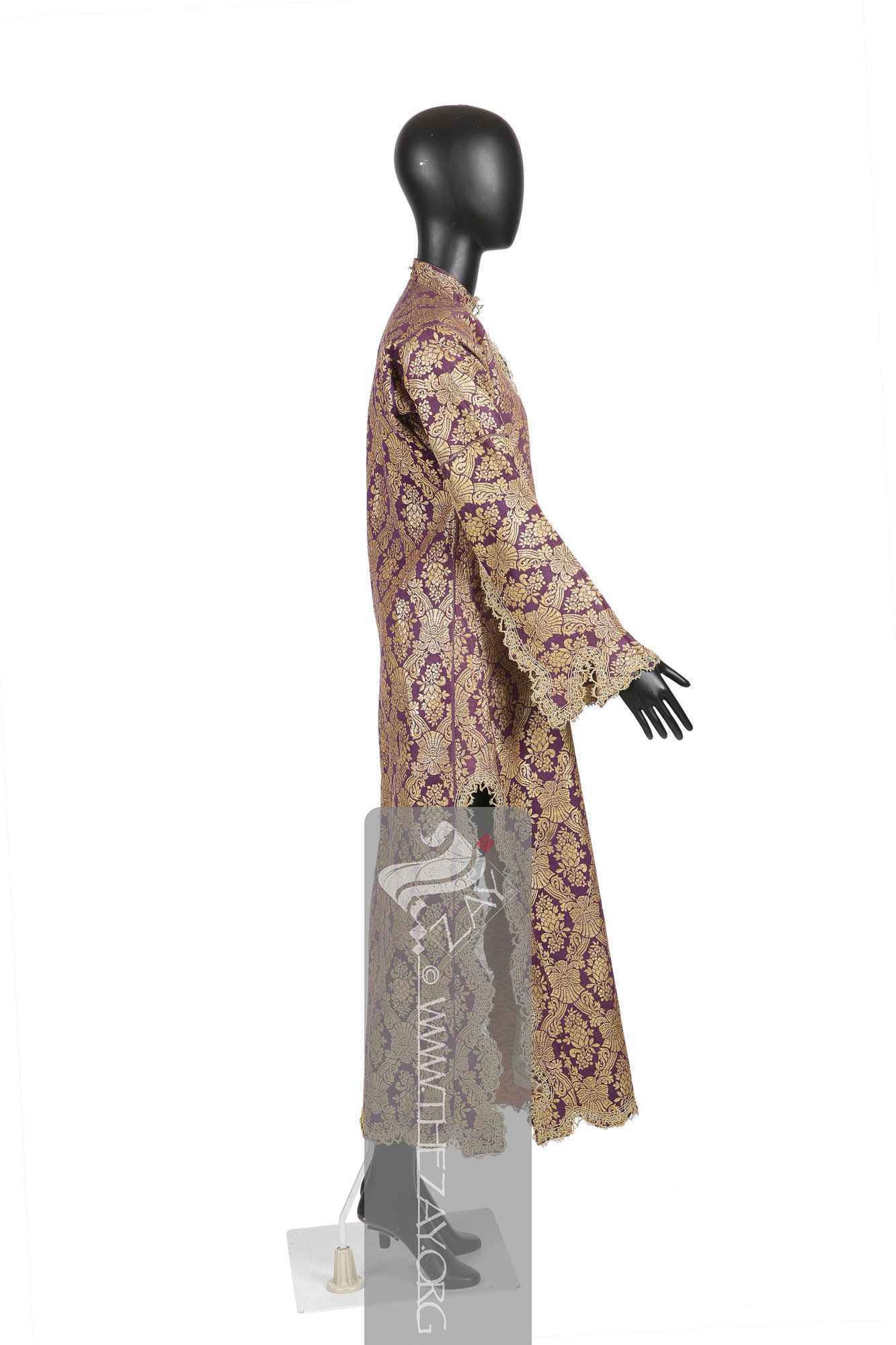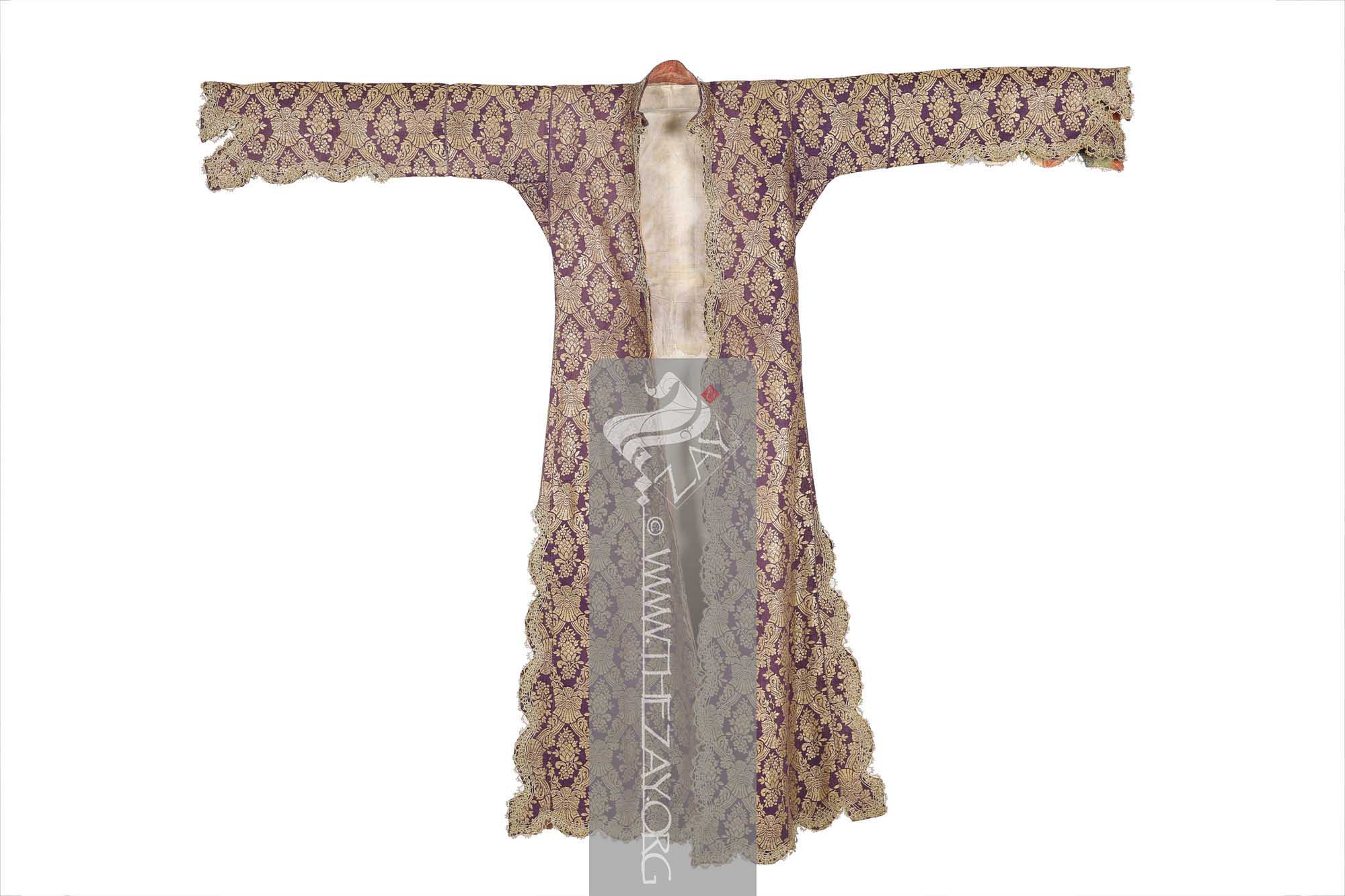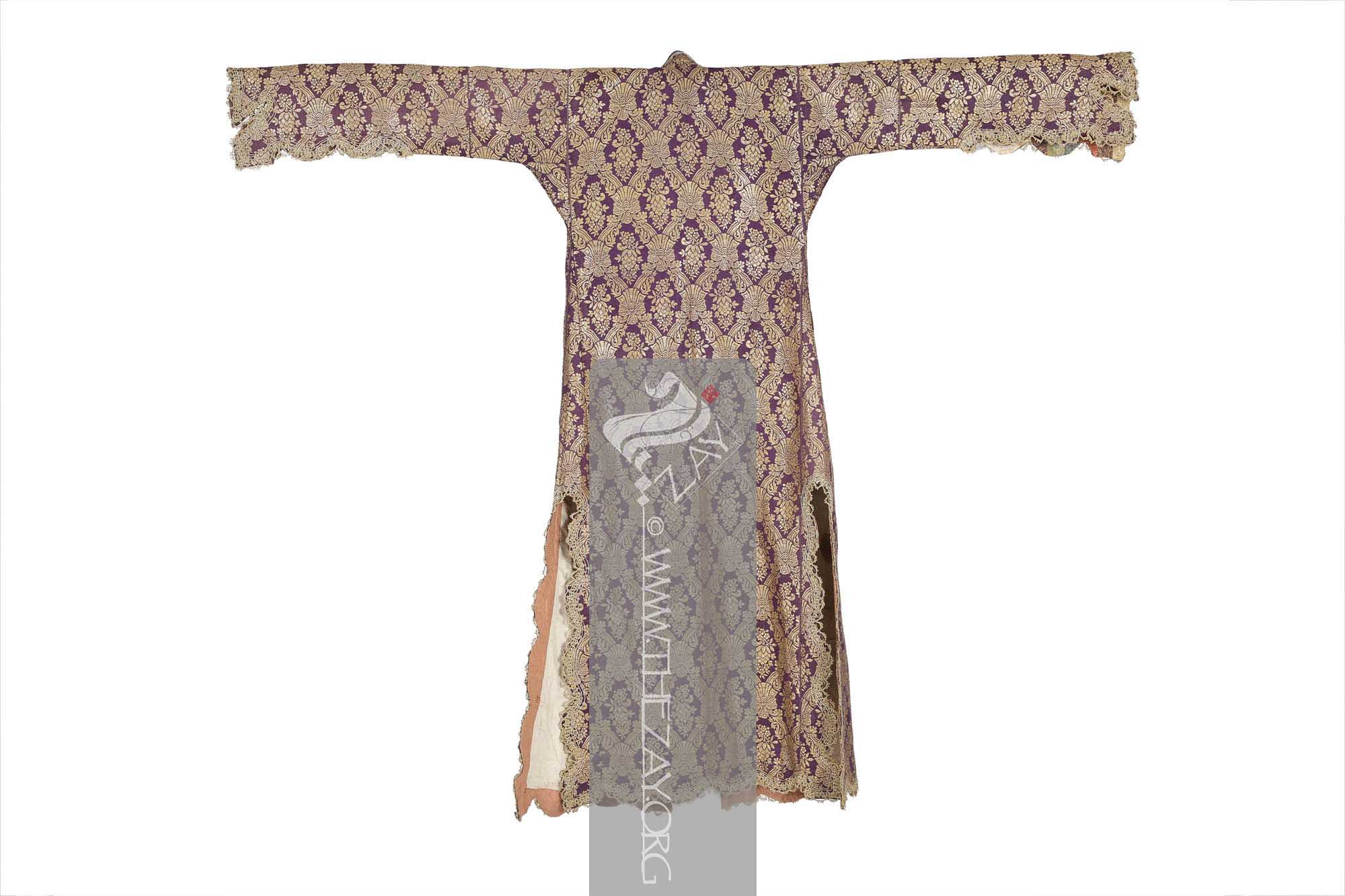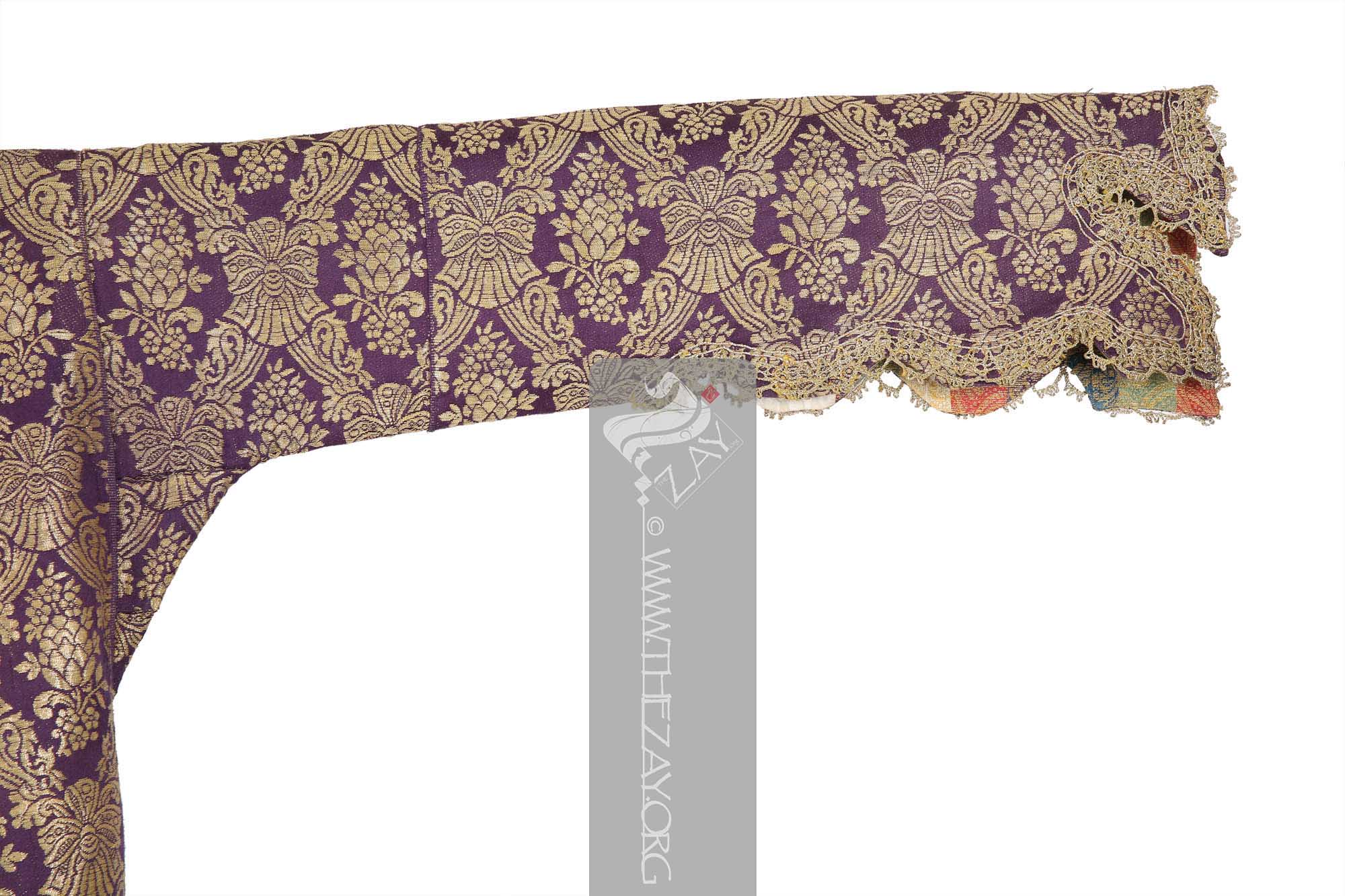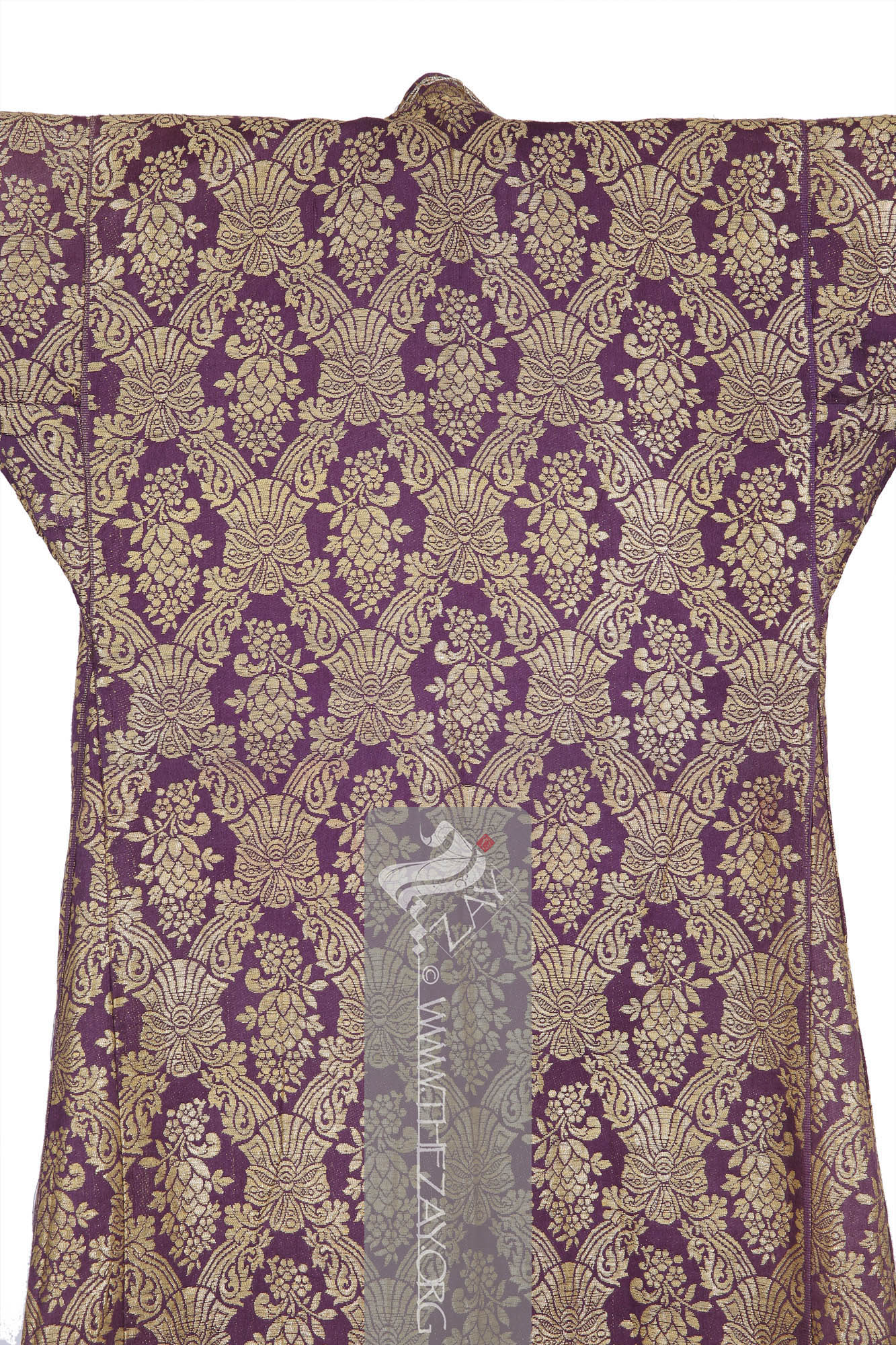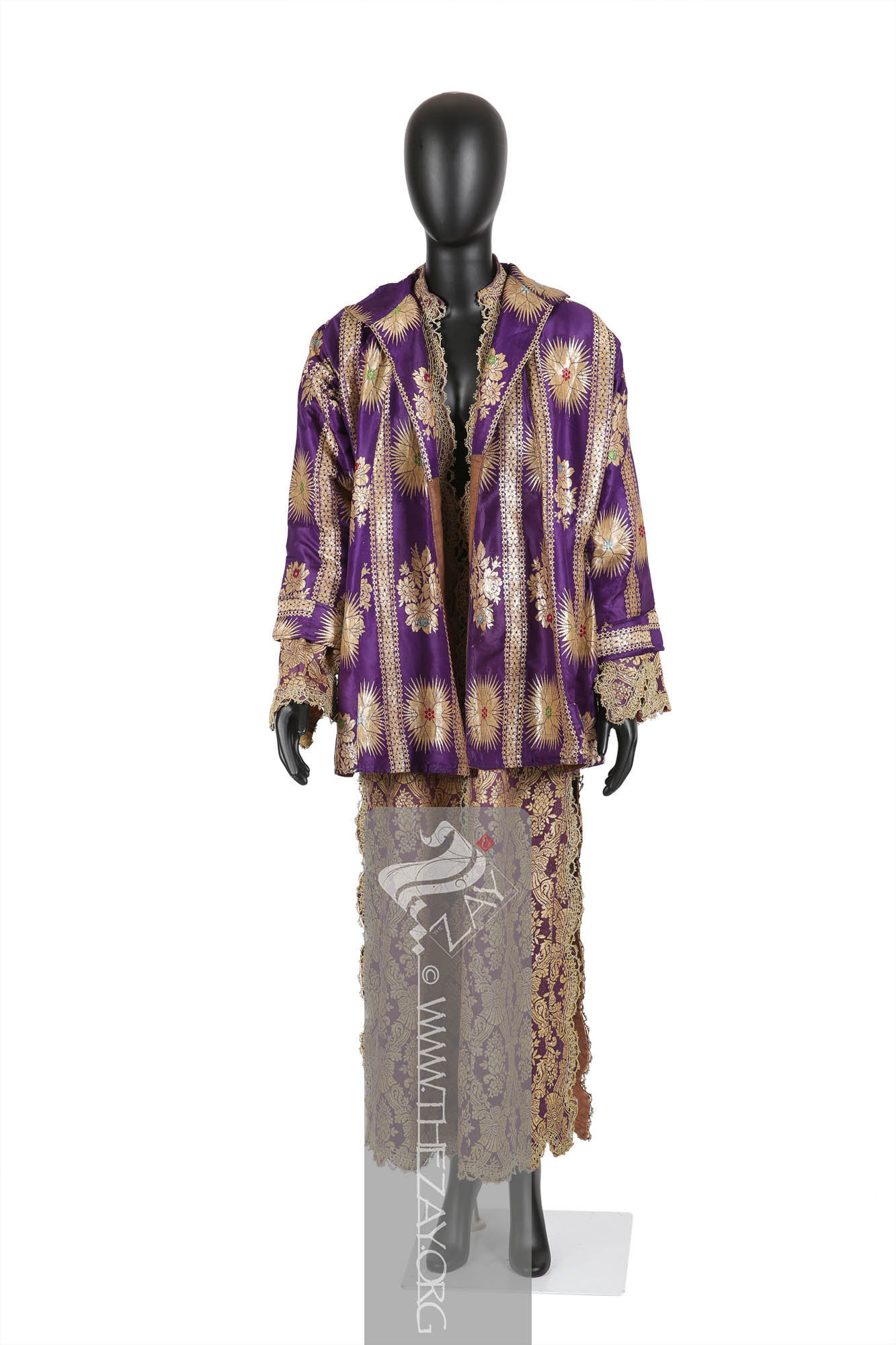Object NotePart of a lot possibly from the same ensembles with one more item (
ZI2019.500645a ASIA).
Object History This piece of garment was purchased by
Dr. Reem Tariq
Ṭariq: (Arabic; Synonym: tulle_bi_talli
Tūlle_bi_tallī: (French: Tulle – a city in France where fine material for veil was first made; Turkish: tel – wire; Synonym: tariq; talli; badla; khus_dozi ), series of small metal knots made on a woven net ground as embellishment. The term is commonly used in the North African Arab region specifically in Egypt.
; talli; badla; khus_dozi ), series of small metal knots made on a woven net ground as embellishment. The term is commonly used in the Levant Arab region specifically in Lebanon.
El Mutwalli
Dr. Reem Tariq
Ṭariq: (Arabic; Synonym: tulle_bi_talli
Tūlle_bi_tallī: (French: Tulle – a city in France where fine material for veil was first made; Turkish: tel – wire; Synonym: tariq; talli; badla; khus_dozi ), series of small metal knots made on a woven net ground as embellishment. The term is commonly used in the North African Arab region specifically in Egypt.
; talli; badla; khus_dozi ), series of small metal knots made on a woven net ground as embellishment. The term is commonly used in the Levant Arab region specifically in Lebanon.
el Mutwallī: Founder (CEO) of the Zay
Zay: (Arabic: costume, Pl. azyaā’), a set of clothes in a style typical of a particular country or historical period. Initiative, a public figure, speaker and author. An expert curator and consultant in Islamic art and architecture, interior design, historic costume, and UAE heritage. from
Kerry Taylor Auctions, London in 2019 to add to and enhance The
Zay
Zay: (Arabic: costume, Pl. azyaā’), a set of clothes in a style typical of a particular country or historical period. Initiative Collection.
Object Features This is a heavily embellished
brocade
Brocade: (Italian: brocco – twisted thread), is a richly decorative fabric woven with an intricate raised pattern. Its origins can be traced back to ancient China, where it was made for the imperial court. It later spread to Europe during the Renaissance and became popular in couture and decorative arts. silk women’s jacket (
entari
: (Turkish; Synonym: Antari), a traditional Turkish long jacket-like unisex garment worn during the Ottoman era. It often featured an open front with long sleeves and was worn over an undershirt and a pair of trousers and was sometimes layered by a short waist or hip-length jacket. ) woven in purple silk and metal–gold and silver – threads.
The field of the
entari
: (Turkish; Synonym: Antari), a traditional Turkish long jacket-like unisex garment worn during the Ottoman era. It often featured an open front with long sleeves and was worn over an undershirt and a pair of trousers and was sometimes layered by a short waist or hip-length jacket. has repeats of thick stylised trellis motif similar to (çatkili) – a term used to describe both the motif and the garment when embroidered with this motif – composed of foliage and branches.
The centre of each trellis features a bouquet with a central pinecone-like motif resembling an artichoke flanked by floral motifs. The interlocking of each trellis features a bow-like motif resting on a bell-shaped base. Either side of the
entari
: (Turkish; Synonym: Antari), a traditional Turkish long jacket-like unisex garment worn during the Ottoman era. It often featured an open front with long sleeves and was worn over an undershirt and a pair of trousers and was sometimes layered by a short waist or hip-length jacket. displays a long slit with a pocket at its end which divides the skirt into three segments, thus making it an (üçetek_entari).
The hemline of the
entari
: (Turkish; Synonym: Antari), a traditional Turkish long jacket-like unisex garment worn during the Ottoman era. It often featured an open front with long sleeves and was worn over an undershirt and a pair of trousers and was sometimes layered by a short waist or hip-length jacket. is scalloped with wide crocheted needle lace (
oya
Oyā: (Turkish), refers to various forms of narrow needle lace trimmings common to eastern and southern Mediterranean regions and parts of Armenia. Believed to be a derivative of Venetian lace it is considered an indelible part of the traditional craft of Türkiye today. ) trimming made of metal–gold–thread (
sirma
Sirma: (Byzantine Greek: súrma – a dragging motion, from Ancient Greek: súrō – to draw; Synonym: Tel_sirma
Tel_sirma: (Ottoman Turkish: tel – wire, thread, chord; Byzantine Greek: súrma – a dragging motion from Ancient Greek: súrō – to draw; Synonym: Sirma), a metal lace or thread traditionally made of silver or gold and sometimes even copper often used textile embellishments such as embroidery and weaves like brocades. ), a metal lace or thread traditionally made of silver or gold and sometimes even copper often used textile embellishments such as embroidery and weaves like brocades. )/(
tel_sirma
Tel_sirma: (Ottoman Turkish: tel – wire, thread, chord; Byzantine Greek: súrma – a dragging motion from Ancient Greek: súrō – to draw; Synonym: Sirma), a metal lace or thread traditionally made of silver or gold and sometimes even copper often used textile embellishments such as embroidery and weaves like brocades. ). The
oya
Oyā: (Turkish), refers to various forms of narrow needle lace trimmings common to eastern and southern Mediterranean regions and parts of Armenia. Believed to be a derivative of Venetian lace it is considered an indelible part of the traditional craft of Türkiye today. trimmings cover the edges of the scalloped front panels, the high side slits, the fall hem as well as the cuffs.
The field of the piece is lined with an ivory cotton fabric while the edges are lined with a plain (
coral
Coral: (Greek: korallion, probably from Hebrew: goral – small pebbles), is a pale to medium shade of pink with orange or peach undertones, resembling the colour of certain species of coral.) pink cotton fabric.
The cuffs are lined with another
brocade
Brocade: (Italian: brocco – twisted thread), is a richly decorative fabric woven with an intricate raised pattern. Its origins can be traced back to ancient China, where it was made for the imperial court. It later spread to Europe during the Renaissance and became popular in couture and decorative arts. fabric woven in gold on vertical panels of
turquoise
Turquoise: (French: turquois – present day Türkiye; Synonyms: firuze, pheroza), is a naturally occurring opaque mineral mined in abundance in Khorasan province of Iran and has been used for making dye for centuries. The term is a derivative of the French word for the country Türkiye once called Turkey. , ivory, red, purple, and blue silk base. This is to make sure that if the wearer were to turn the cuffs to shorten the length of the sleeves the underside of the cuffs would also be richly embellished.
The incorporation of indigenous botanical elements – such as the artichoke in this case – and occasional animal motifs in decorative arts have always held a significant place in Turkish culture.
Along with this, there is a longstanding tradition of embroidery and garment-making amongst Turkish women that is deeply rooted in their cultural heritage. Through the adornment of fabrics with region-specific motifs, inspired by the diverse flora and fauna and coupled with techniques such as intricate crocheting and distinctive embroideries, this artistic practice has transcended mere skill display to become an integral societal element distinctive to the Turkic tribes of the region.
Women employ these symbolic motifs intertwined with their techniques as a means of engaging in covert communication, conveying a range of messages encompassing emotions and even marital status amongst themselves.
At its peak, the Ottoman Empire spanned three continents and served as the crossroads between the east and the West – the Fertile Crescent, the Levant, Eastern Europe including the Balkans till the southern edge of the Great Hungarian Plain, Northern Africa and Eastern Mediterranean.
After the conquest of the Arab world in c. 1516-1517 CE its control over the Middle East lasted for four centuries until the early 20th century with the onset of WW I and the Arab Revolt. These four hundred years witnessed many instances of mutual Arab and Ottoman cultural influences and exchanges. Through areas such as social life and art – decorative and performing –we come across several instances of Arab and Turkish culture blending through the centuries.
Just as European fashion was often inspired by the French court this socio-cultural blending between Ottoman Turkey and the Middle East was reflected in its fashion and material culture.
Thus, while emulating Ottoman fashion as the mark of class in the Arab world was one side of the puzzle adapting Eastern European fashion particularly Balkan as part of mainstream couture culture because of the sizable Balkan population within the Empire was another. Therefore, it is not surprising to find several articles of clothing and their terms similar between the two cultures.
Links
- Cangökçe, Hadiye, et al. Osmanlı İmparatorluğu’nun Son Döneminden Kadın Giysileri = Women’s Costume of the Late Ottoman Era from the Sadberk Hanım Museum Collection. Sadberk Hanım Museum, 2010.
- Küçükerman, Önder, and Joyce Matthews. The Industrial Heritage of Costume Design in Turkey. GSD Foreign Trade Co. Inc, 1996.
- AĞAÇ, Saliha, and Serap DENGİN. “The Investigation in Terms of Design Component of Ottoman Women Entari
: (Turkish; Synonym: Antari), a traditional Turkish long jacket-like unisex garment worn during the Ottoman era. It often featured an open front with long sleeves and was worn over an undershirt and a pair of trousers and was sometimes layered by a short waist or hip-length jacket. in 19th Century and Early 20th Century.” International Journal of Science Culture and Sport (IntJSCS), vol. 3, no. 1, Mar. 2015, pp. 113–125. https://dergipark.org.tr/tr/download/article-file/91778
- Parker, Julianne. “OTTOMAN AND EUROPEAN INFLUENCE IN THE NINTEENTH-CENTURY BRIDAL COLLECTION OF THE AZEM PALACE, DAMASCUS, SYRIA.” Journal of Undergraduate Research: Brigham Young University, 18 Sept. 2013. http://jur.byu.edu/?p=6014
- Koç, Adem. “The Significance and Compatibility of the Traditional Clothing-Finery Culture of Women in Kutahya in Terms of Sustainability.” Milli Folklor, vol. 12, no. 93, Apr. 2012. 184. https://www.millifolklor.com/PdfViewer.aspx?Sayi=93&Sayfa=181
- Micklewright, Nancy. “Late-Nineteenth-Century Ottoman Wedding Costumes as Indicators of Social Change.” Muqarnas, vol. 6, 1989, pp. 161–74. JSTOR, https://doi.org/10.2307/1602288. Accessed 13 July 2023.
- Micklewright, Nancy. “Looking at the Pst: Nineteenth-Century Images of Constantinople and Historic Documents.” Expedition, vol. 32, no. 1, pp. 24–32. https://www.penn.museum/documents/publications/expedition/pdfs/32-1/micklewright.pdf
- Ozgen, Ozlen, et al. “Henna Ritual Clothing in Anatolia from Past to Present: An Evaluation on Bindalli.” Textile Society of America Symposium Proceedings, 2021, https://doi.org/10.32873/unl.dc.tsasp.0122.
- Denny, Walter B., and Sumru Belger Krody. The Sultan’s Garden: The Blossoming of Ottoman Art. The Textile Museum, 2012. https://museum.gwu.edu/sites/g/files/zaxdzs3226/f/Sultans%20Garden%20Catalogue.pdf
- Ersoy, Ayla. Traditional Turkish Arts. Ministry of Culture and Tourism Publications, 2008. https://teda.ktb.gov.tr/Eklenti/6593,traditionalturkishartspdf.pdf?0
- https://www.metmuseum.org/art/collection/search/451160
- https://collections.vam.ac.uk/item/O90892/entari
: (Turkish; Synonym: Antari), a traditional Turkish long jacket-like unisex garment worn during the Ottoman era. It often featured an open front with long sleeves and was worn over an undershirt and a pair of trousers and was sometimes layered by a short waist or hip-length jacket. -unknown/
- https://www.metmuseum.org/art/collection/search/85546
- https://www.metmuseum.org/art/collection/search/85540
- https://islamicart.museumwnf.org
- https://www-kutahya-gov-tr.translate.goog/geleneksel-giysi
- https://archive.aramcoworld.com/issue/200703/the.skill.of.the.two.hands.htm
- http://www.turkishculture.org/textile-arts/clothing/womens-garments/womens-garments
- http://jezebeljane.blogspot.com/2015/09/womens-clothing-in-16th-century-turkey
- https://www.issendai.com/16thcenturyistanbul/visual-dictionary/kaftan/
- https://babogenglish.wordpress.com/2016/02/25/turkey-general-information/
- https://ertugrulforever.com/turkish-fashion-2021/
- https://northamericaten.com/turkish-clothing-of-ottoman-times/
- https://www.al-monitor.com/originals/2019/04/turkish-traditional-costumes-from-head-to-toe





